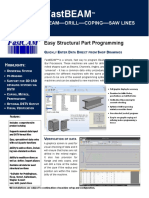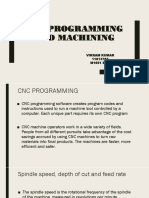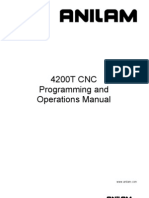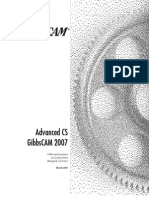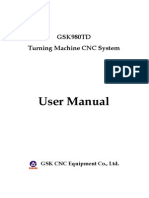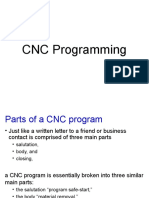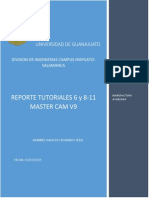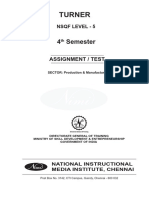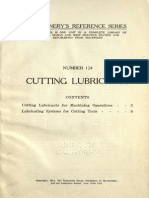3 Fundamentals of CNC Programming I (CNC Course CD)
Uploaded by
Jimmy Rodriguez3 Fundamentals of CNC Programming I (CNC Course CD)
Uploaded by
Jimmy RodriguezCNC MACHINING : TECHNOLOGY AND ECONOMIC CONCERNS
Lecture 3 Fundamentals of CNC Programming I Axis and Motion Nomenclature CNC Milling Fundamentals CNC Lathe Fundamentals
INSTRUCTOR: DR. KUNWAR FARAZ AHMED
Axis and Motion Nomenclature
Machine coordinate system?
The direction of each finger represents the positive direction of motion. The axis of the main spindle is always Z, and the positive direction is into the spindle. On a mill the longest travel slide is designated the X axis and is always perpendicular to the Z axis.
If you rotate your hand looking into your middle finger, the forefinger represents the Y axis. The base of your fingers is the start point or (X0, Y0, Z0).
(2)
Axis and Motion Nomenclature
Rotary Motion
The right-hand rule for determining the correct axis on a CNC machine may also be used to determine the clockwise rotary motion about X, Y, and Z. To determine the positive, or clockwise, direction about an axis, close your hand with the thumb pointing out. The thumb may represent the X, Y, or Z direction and the curl of the fingers may represent the clockwise, or positive, rotation about each axis. These are known as A, B, and C and represent the rotary motions about X, Y, and Z, respectively.
(3)
Axis and Motion Nomenclature
CNC Mill
On this gantry mill the spindle travels along the X Axis. The travel direction of the table designates the Y Axis.
The Z Axis is designated by the stationary vertical column.
(4)
Axis and Motion Nomenclature
CNC Lathe
On most CNC lathes the Z Axis is parallel to the spindle
X Axis is perpendicular to the spindle Z Axis is longer than the X Axis.
(5)
Axis and Motion Nomenclature
5 Axis CNC Contour Mill
On this five-axis horizontal contour milling machine, note the orientation of the X and Y axes in relation to the Z Axis. The rotary axes for both the X and Y axes are designated by the A and B rotary tables.
(6)
Axis and Motion Nomenclature
Vertical CNC Knee Mill
On a common vertical knee CNC mill the spindle is stationary while the rest of the components move according to their axis designations (X, Y, and Z).
(7)
Axis and Motion Nomenclature
CNC Punch Machine
On a CNC punch press the part is moved in the X and Y directions while the punch is stationary
(8)
CNC Milling Fundamentals
Three Cartesian Planes
The three planes in the Cartesian coordinate system are XY, XZ, and YZ. These are referred to as G17, G18, and G19, respectively, on the mill.
(9)
CNC Milling Fundamentals
The Part Reference Zero (PRZ)
There are two reference points on a CNC Machine: Machine Reference Zero (MRZ) and the Part Reference Zero (PRZ). All coordinates are based on these two points.
- All CNC machine tools require a reference point from which to base coordinates.
- It is generally easier to use a point on the workpiece itself for reference, because the coordinates apply to the part anyway thus the PRZ designation
- The PRZ is defined as the lower left-hand corner and the top of the stock of each part
(10)
CNC Milling Fundamentals
The Part Reference Zero (PRZ)
The advantages of having the PRZ at the lower left top corner are:
- Geometry creation is in the positive XY plane for CAD/CAM systems - The corner of the workpiece is easy to find. - All negative Z depths are below the surface of the workpiece.
(11)
CNC Milling Fundamentals
The Cartesian Graph
Cartesian coordinates were invented by Ren Descartes, who is famous for the phrase "I think, therefore I am."
Most Cartesian graphs for milling and turning use a three-axis coordinate system, denoted by the X, Y, and Z axes. These coordinates are used to instruct the machine tool where to move on the workpiece
(12)
CNC Milling Fundamentals
Absolute Coordinates
Absolute coordinates use the origin as the reference point.
This means that any point on the Cartesian graph can be plotted accurately by measuring the distance from the origin to the point First in the X direction, then in the Y direction, and then, if applicable, in the Z direction.
(13)
CNC Milling Fundamentals
Incremental Coordinates
Incremental coordinates use the present position as the reference point for the next movement.
This means that any point in the Cartesian graph can be plotted accurately by measuring the distance between points, generally starting at the origin.
(14)
CNC Milling Fundamentals
Cartesian Coordinates
(15)
CNC Milling Fundamentals
Absolute Coordinates Exercise 1
Fill in the X and Y blanks with the appropriate absolute coordinates for points A through H. A: X_____, Y_____ B: X_____, Y_____ C: X_____, Y_____ D: X_____, Y_____ E: X_____, Y_____ F: X_____, Y_____ G: X_____, Y_____ H: X_____, Y_____
(16)
CNC Milling Fundamentals
Incremental Coordinates Exercise 2
Fill in the X and Y blanks with the appropriate incremental coordinates for points A through H. A: X_____, Y_____ B: X_____, Y_____ C: X_____, Y_____ D: X_____, Y_____ E: X_____, Y_____ F: X_____, Y_____ G: X_____, Y_____ H: X_____, Y_____
(17)
CNC Turning Fundamentals
Axis Coordinate System CNC lathes share the same two-axis coordinate system. This allows for the transfer of CNC programs among different machines, as all measurements are derived from the same reference points. In CNC turning there is a primary, or horizontal, axis and a secondary, or vertical, axis. Because the major axis always runs through the spindle(horizontally), the Z axis is usually the longer one. The X axis is perpendicular to the Z axis (or vertical). It is important to remember that on most CNC lathes the tool post is on the top, or backside, of the machine, unlike on a conventional lathe.
(18)
CNC Turning Fundamentals
Cartesian Graph for Turning
When measuring X and Z coordinates, use a central reference point. Start all measurements at this reference point, the origin point (X0, Z0). For all our examples the origin is located at the center right-hand endpoint of the workpiece. Keep in mind that at times the center left-hand endpoint of the workpiece may be used
(19)
CNC Turning Fundamentals
Diameter Programming
Diameter (or diametrical) programming relates the X axis to the diameter of the workpiece.
For example, if the workpiece has a 5-in outside diameter and you want to command an absolute move to the outside, you would program X5.0
(20)
CNC Turning Fundamentals
Radial Programming
Radius (or radial) programming relates the X axis to the radius of the workpiece.
For example, for the same 5-in. outside diameter workpiece, you would program X2.5 to move the tool to the outside.
(21)
CNC Turning Fundamentals
Absolute Coordinates
When plotting points using absolute coordinates, always start at the origin (X0, Z0). Then travel along the Z axis until you reach a point directly below the point that you are trying to plot. Write down the Z value and then go up until you reach your point. Write down the X value. You now have the XZ (or ZX) coordinate for that point.
(22)
CNC Turning Fundamentals
Incremental Coordinates
The second method for finding points in a Cartesian coordinate system is by using incremental coordinates. Incremental, or relative, coordinates use each successive point to measure the next coordinate. Instead of constantly referring back to the origin, the incremental method refers to the previous point
(23)
CNC Milling Fundamentals
Incremental Coordinates Exercise 3
Using Incremental Coordinates. Find the diametrical X and Z coordinates for points A through E. A: X_____, Y_____ B: X_____, Y_____ C: X_____, Y_____ D: X_____, Y_____ E: X_____, Y_____ H: X_____, Y_____
(24)
CNC Milling Fundamentals
Absolute Coordinates Exercise 4
Using Absolute Coordinates. Find the diametrical X and Z coordinates for points A through E. A: X_____, Z_____ B: X_____, Z_____ C: X_____, Z_____ D: X_____, Z_____ E: X_____, Z_____
(25)
CNC Milling Fundamentals
Absolute Coordinates Exercise 4
Using Absolute Coordinates. Find the diametrical X and Z coordinates for points A through E. A: X_____, Z_____ B: X_____, Z_____ C: X_____, Z_____ D: X_____, Z_____ E: X_____, Z_____
(26)
CNC PROGRAM CODES
Letter Codes Each instruction to the machine consists of a letter followed by a number. Each letter is associated with a specific type of action or piece of information needed by the machine. Letters used in Codes N,G,X,Y,Z,A,B,C,I,J,K,F,S,T,R,M
(27)
CNC PROGRAM CODES
Letter Codes G Codes
(28)
CNC PROGRAM CODES
Letter Codes G & M Codes G-codes: Preparatory Functions involve actual tool moves M-codes: Miscellaneous Functions involve actions necessary for machining (i.e. spindle on/off, coolant on/off)
(29)
CNC PROGRAM CODES
Letter Codes M Codes
(30)
CNC PROGRAM CODES
Tool Motion Codes Generally, three types of tool motion are used on a CNC machine: G00 Rapid tool move. Non-machining command. Each axis trajectory is exhausted as fast as the motor can drive the axes. Straight-line feed move. Linear interpolation. Coordinated moves at a controlled feedrate
G01
G02/G03 Two-dimensional arc feed moves. Circular interpolation.
(31)
CNC PROGRAM CODES
Letter Codes N Codes N-codes: Gives an identifying number for each block of information. It is generally good practice to increment each block number by 5 or 10 to allow additional blocks to be inserted if future changes are required.
(32)
CNC PROGRAM CODES
Letter Codes X Y & Z Codes X, Y, and Z codes are used to specify the coordinate axis. Number following the code defines the coordinate at the end of the move relative to an incremental or absolute reference point. The number may require that a specific format be used (i.e. 3.4 means three numbers before the decimal and four numbers after the decimal).
(33)
CNC PROGRAM CODES
Letter Codes I J & K Codes I, J, and K Codes are used to specify the coordinate axis when defining the centre of a circle. Number following the code defines the coordinate at the end of the move relative to an incremental or absolute reference point. The number may require that a specific format be used (i.e. 3.4 means three numbers before the decimal and four numbers after the decimal).
(34)
CNC PROGRAM CODES
Letter Codes F S & T Codes F-Code: used to specify the feedrate S-Code: used to specify the spindle speed T-Code: used to specify the tool identification number associated with the tool to be used in subsequent operations.
(35)
CNC PROGRAM CODES
Letter Codes R & P Codes R-Code: - Retract distance when used with G81, 82, and 83. - Radius when used with G02 and G03. P-Code: Used to specify the dwell time associated with G04.
(36)
CNC PROGRAM CODES
Modal G Codes Most G Codes set the machine in a mode which stays in effect until it is changed or cancelled by another G Code These commands are called modal In the example, G00 and G01 are modal
(37)
CNC PROGRAM CODES
Modal G Codes
(38)
You might also like
- Milling Simulation: Metal Milling Mechanics, Dynamics and Clamping PrinciplesFrom EverandMilling Simulation: Metal Milling Mechanics, Dynamics and Clamping PrinciplesNo ratings yet
- Improve CNC Productivity With Parametric ProgrammingNo ratings yetImprove CNC Productivity With Parametric Programming37 pages
- Anilam 4200t CNC Programming and Operations ManualNo ratings yetAnilam 4200t CNC Programming and Operations Manual355 pages
- CNC Milling Lab Handbook - For StudentsNo ratings yetCNC Milling Lab Handbook - For Students16 pages
- English - Lathe NGC - Operator's Manual - 2018No ratings yetEnglish - Lathe NGC - Operator's Manual - 2018456 pages
- Chess Pieces Manufacturing Description Part2No ratings yetChess Pieces Manufacturing Description Part210 pages
- Hommel-Etamic Measuring Systems: Geometrical Tolerancing in PracticeNo ratings yetHommel-Etamic Measuring Systems: Geometrical Tolerancing in Practice1 page
- ME312 - Non-Traditional Machining and USMNo ratings yetME312 - Non-Traditional Machining and USM45 pages
- GSK980TD Turning Machine CNC System User Manual (English Version)No ratings yetGSK980TD Turning Machine CNC System User Manual (English Version)408 pages
- 01 & 02 Introduction To CNC Technology (In Powerpoint Format)100% (3)01 & 02 Introduction To CNC Technology (In Powerpoint Format)145 pages
- Computer Numerical Control CNC: Ken Youssefi Mechanical Engineering DepartmentNo ratings yetComputer Numerical Control CNC: Ken Youssefi Mechanical Engineering Department43 pages
- Computer Numeric Control: Utkarsh AgarwalNo ratings yetComputer Numeric Control: Utkarsh Agarwal30 pages
- Making Threads by Various Methods ReportNo ratings yetMaking Threads by Various Methods Report11 pages
- The Text Used On A Typical Detail Sheet Should Be - Placed HorizontallyNo ratings yetThe Text Used On A Typical Detail Sheet Should Be - Placed Horizontally30 pages
- CNC Programming & Application: Federal TVET Institute Manufacturing Technology Department Addis Abeba EthiopiaNo ratings yetCNC Programming & Application: Federal TVET Institute Manufacturing Technology Department Addis Abeba Ethiopia58 pages
- FEBRUARY 2020 Surplus Record Machinery & Equipment DirectoryNo ratings yetFEBRUARY 2020 Surplus Record Machinery & Equipment Directory717 pages
- Mmu - Ic.polyu - Edu.hk Handout 0102 0102No ratings yetMmu - Ic.polyu - Edu.hk Handout 0102 010210 pages
- Build Your Dream Car Alfa Romeo Vintage in Wood100% (2)Build Your Dream Car Alfa Romeo Vintage in Wood32 pages
- Model Design and Analysis Improvement of CNC LatheNo ratings yetModel Design and Analysis Improvement of CNC Lathe8 pages
- Computer Numerical Control Programming BasicsFrom EverandComputer Numerical Control Programming Basics
- Milling Simulation: Metal Milling Mechanics, Dynamics and Clamping PrinciplesFrom EverandMilling Simulation: Metal Milling Mechanics, Dynamics and Clamping Principles
- Improve CNC Productivity With Parametric ProgrammingImprove CNC Productivity With Parametric Programming
- Anilam 4200t CNC Programming and Operations ManualAnilam 4200t CNC Programming and Operations Manual
- Hommel-Etamic Measuring Systems: Geometrical Tolerancing in PracticeHommel-Etamic Measuring Systems: Geometrical Tolerancing in Practice
- GSK980TD Turning Machine CNC System User Manual (English Version)GSK980TD Turning Machine CNC System User Manual (English Version)
- 01 & 02 Introduction To CNC Technology (In Powerpoint Format)01 & 02 Introduction To CNC Technology (In Powerpoint Format)
- Computer Numerical Control CNC: Ken Youssefi Mechanical Engineering DepartmentComputer Numerical Control CNC: Ken Youssefi Mechanical Engineering Department
- The Text Used On A Typical Detail Sheet Should Be - Placed HorizontallyThe Text Used On A Typical Detail Sheet Should Be - Placed Horizontally
- CNC Programming & Application: Federal TVET Institute Manufacturing Technology Department Addis Abeba EthiopiaCNC Programming & Application: Federal TVET Institute Manufacturing Technology Department Addis Abeba Ethiopia
- SolidWorks 2017 Black Book: SolidWorks Black BookFrom EverandSolidWorks 2017 Black Book: SolidWorks Black Book
- FEBRUARY 2020 Surplus Record Machinery & Equipment DirectoryFEBRUARY 2020 Surplus Record Machinery & Equipment Directory
- Model Design and Analysis Improvement of CNC LatheModel Design and Analysis Improvement of CNC Lathe







